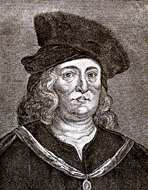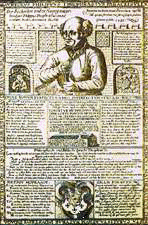Paracelsus: Alchemical Genius of the Middle Ages
A. Cockren
Paracelsus
CONTENTS
His Youth
Auroleus Phillipus Theostratus Bombastus von Hohenheim, immortalized as “Paracelsus,” was born in 1493. He was the son of a well known physician who was described a Grand Master of the Teutonic Order, and it was from him that Paracelsus took his first instruction in medicine. At the age of sixteen, Paracelsus entered the University at Basle where he applied himself to the study of alchemy, surgery, and medicine. With the science of alchemy he was already acquainted, having previously studied the works of Isaac Hollandus. Hollandus’ writing roused in him the ambition to cure disease by medicine superior to those available at that time to use, for apart from his incursions into alchemy, Paracelsus is credited with the introduction of opium and mercury into the arsenal of medicine. His works also indicate an advanced knowledge of the science and principles of magnetism. These are just some of the achievements that seem to justify the praise that has been handed him in the last century. Manly Hall called him “the precursor of chemical pharmacology and therapeutics and the most original medical thinker of the sixteenth century.”
His Travels
The Abbot Trithermius, an adept of a high order, and the instructor of the illustrious Henry Cornelius Agrippa, was responsible for Paracelsus’ initiation into the science of alchemy. In 1516, Paracelsus was still pursuing his research in mineralogy, medicine, surgery, and chemistry under the guidance of Sigismund Fugger, a wealthy physician of the Basle, but the student was forced to leave the city hurriedly after trouble with the authorities over his studies in necromancy. So, Paracelsus started out on a nomad’s life, supporting himself by astrological predictions and occult practices of various kinds.
His wanderings took him through Germany, France, Hungary, the Netherlands, Denmark, Sweden, and Russia. In Russia, he was taken prisoner by the Tartars and brought before the Grand Cham at whose court he became a great favorite. Finally, he accompanied the Cham’s son on an embassy from China to Constantinople, the city in which the supreme secret, the universal dissolvent (the alkahest) was imparted to him by an Arabian adept. For Paracelsus, as Manly Hall has said, gained his knowledge “not from long-coated pedagogues but from dervishes in Constantinople, witches, gypsies, and sorcerers, who invoked spirits and captured the rays of the celestial bodies in dew; of whom it is said that he cured the incurable, gave sight to the blind, cleansed the leper, and even raised the dead, and whose memory could turn aside the plague.”
His Return to Europe
Paracelsus ultimately returned to Europe, passing along the Danube into Italy, where he became an army surgeon. It was here apparently that his wonderful cures began. In 1526, at the age of thirty-two, he re-entered Germany, and at the university he had entered as a youth, took a professorship of physics, medicine, and surgery. This was a position of considerable importance that was offered to him at the insistence of Erasmus and Ecolampidus. Perhaps it was his behavior at this time that eventually led to his nickname “the Luther of physicians,” for in his lectures he was so bold as to denounce as antiquated the revered systems of Galen and his school, whose teachings were held to be so unalterable and inviolable by the authorities of that time that the slightest deviation from their teachings was regarded as nothing short of heretical. As a crowning insult he actually burnt the works of these masters in a brass pan with sulfur and nitre!
The Hermetic Heretic
This high-handed behavior, coupled with his very original ideas, made him countless enemies. The fact that the cures he performed with his mineral medicines justified his teachings merely served further to antagonize the medical faculty, infuriated at their authority and prestige being undermined by the teachings of such a “heretic” and “usurper.” Thus Paracelsus did not long retain his professorship at Basle, but was forced once again to leave the city and take to the road in a wanderer’s life.
During the worse of his second exile, we hear of him in 1526 at Colmar and in 1530 at Nuremburg, once again in conflict with the doctors of medicine, who denounced him as an impostor, although once again, he turned the tables on his opponents by his successful treatment of several bad cases of elephantiasis. which he followed up during the next ten years by a series of cures that were amazing for that period.
In his book Paracelsus, Franz Hartmann says: “He proceeded to Machren, Kaernthen, Krain, and Hungary, and finally to Salzburg in Austria, where he was invited by the Prince Palatine, Duke Ernst of Bavaria, who was a great lover of the secret art of alchemy. But Paracelsus was not destined to enjoy the rest he so richly deserved. He died in 1541, after a short sickness, in a small room at the White Horse Inn, and his body was buried in the graveyard of St. Sebastian. At least one writer has suggested that his death may have been hastened by a scuffle with assassins in the pay of the orthodox medical faculty, but there is no actual foundation for this story.
What is odd is that not one of his biographers seems to have found anything remarkable in the fact that at sixteen years of age, Paracelsus was already well acquainted with alchemical literature. Even allowing for the earlier maturity of a man in those times, he must still have been something of a phenomenon in mental development. Certainly, few of his contemporaries either could or would grasp his teachings, and his consequent irritation and arrogance in the face of their stupidity and obstinacy is scarcely to be wondered at. Although he numbered many enemies among his fellow physicians, Paracelsus also had his disciples, and for them no praise was too high for him. He was worshipped as their noble and beloved alchemical monarch, the “German Hermes.”

Paracelsus

An old woodcut describes Paracelsus’ theories of alchemisitc medicine.





